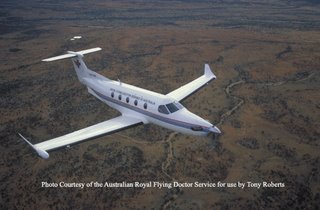
Well, here's the Pilatus PC12. It's my job to fly this wonderful aeroplane and I'm having a great time...
It carries two stretcher patients and up to two sitting patients or escorts, along with the Flight Nurse and of course the pilot (me). We generally only have one or two patients at any one time, and a doctor rarely accompanies us, so it is basically up to me to fly and the nurse to look after what happens in the rear of the aircraft.
We have some excitement at times, operating in all kinds of weather, day or night, and into some pretty inhospitable terrain. However, many of the flights are kind of routine in nature, with hospital transfers being quite common. Occasional emergency flights also see us retrieving patients from all around South Australia and bringing them back to Adelaide or Port Augusta. The kind of emergencies can vary from car accidents, falls, burns and bites, to pregnancies and mental problems. We sometimes carry police escorts to keep the "not so pleasant" patients under control.
On long flights we cruise around 24-28,000' but sometimes we have to stay low (14,000') to keep the cabin altitude at sea level. This is typical for patients who have head injuries for example, where any change in altitude could be VERY dangerous for them.
We can cover a long distance in a very short time, but it is really for trips across the gulf or outback where we save the most time for the patient. If we retrieve a patient from Port Lincoln to Adelaide, it takes around 20 minutes, but if they had to drive, it would be around 7 hours by ambulance! Of course in some cases, the patient wouldn't survive that long. Bringing back a patient from Yalata takes about an hour and a half by air, but probably around 15 hours by road. Again, the aeroplane is often the only practical way to get the job done.









